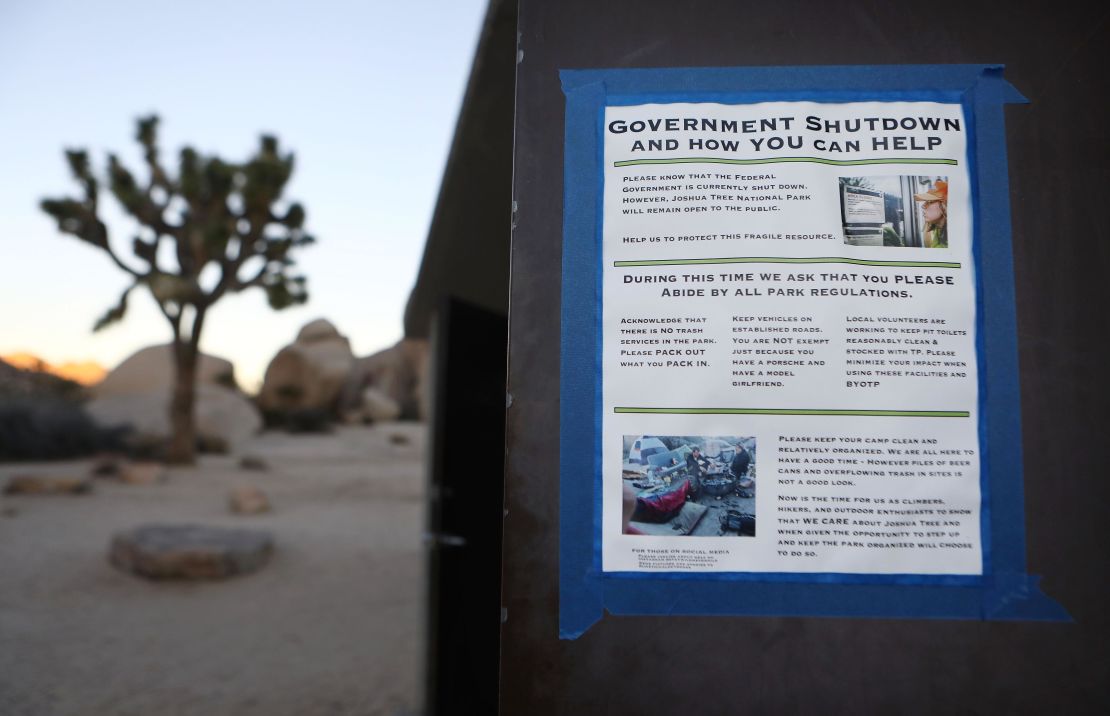Sabra Purdy and Seth Zaharias live just outside Joshua Tree National Park in California and own a rock-climbing tour company. They lost up to 30 percent of their business, Cliffhanger Guides, because of the longest federal shutdown in US history.
During the shutdown, which ended Friday, they and hundreds of other volunteers scoured the park, picking up trash and emptying jammed trash bins. Both even got on their hands and knees and scrubbed toilets in the park, spraying disinfectant and restocking toilet paper.
As the federal government reopens, the husband-and-wife team are preparing for their busy travel season, which Zaharias says stretches from mid-February through the end of April. But they’re concerned that potential visitors to Joshua Tree will be scared off by the possibility of another shutdown after the current deal expires February 15.
“It would be devastating,” Purdy told CNN. “The economics of this town cannot withstand a complete closure of this park, which we experienced in 2013 for 17 days. It damn near killed all of us.”

Rocking the economic boat
The couple’s dilemma is playing out in similar ways for business owners near other national parks whose livelihoods depend on a steady stream of visitors.
Cheryl Connelly co-owns Island Packers, a boat company that ferries passengers to Channel Islands National Park off the Southern California coast.
She said she felt frustrated by the uncertainty.
“We just have to put an extra effort by hitting social media through press releases just to let people know we are still going out to the (Channel) islands. We have to do extra because in 15 days we don’t know what is going to happen,” she said.

Connelly said the confusion around another possible shutdown is casting doubt on vital infrastructure repairs to the park that her business needs to operate effectively.
“We need the piers to be maintained,” she said.
Though federal workers can expect paychecks at least for the next few weeks, the threat of another shutdown means some entrepreneurs working in and around parks can’t bank on a steady income.
Beth Pratt, who oversees the California branch of the National Wildlife Federation, lamented that almost everyone she knows works in Yosemite National Park or runs a business that is tied to the park.
“Friends tell me they don’t know how they are going to make their mortgage payments,” she said.
In some areas where national parks kept their gates open and admitted visitors for free, local businesses actually saw a surge in customers.
Amberae Canfield works the front desk at the Bumbleberry Inn in Springdale, Utah, about a mile from the Zion National Park entrance. She said her occupancy rate during the slow winter season – usually about 10% – jumped to 30% to 50% over the past month.
Zion stayed open throughout the shutdown, and “the free entrance allowed more people to visit,” Canfield said. And the hotel’s restaurant saw “record days during the shutdown,” she added.

Parks feeling the pinch
As local entrepreneurs coped with uncertainty, nonprofits working on the ground at various parks were able to step up to help – for a time.
John Laurentig, who runs Friends of Joshua Tree, estimated his organization saw a 75% spike in donations during the shutdown, which enabled his group to provide interest-free personal loans to federal employees and local contractors.
But Laurentig cautioned against leaning too far on support groups like his. “You need professionals all the time to monitor these national treasures,” he said.
Kerry Gallivan runs Chimani, a company that builds apps that act as national park travel guides. In an email he told CNN, “The partial government shutdown is now starting to severely impact the underlying support systems of the national parks – the nonprofit partners. These groups are losing critical revenue to support the parks and having to lay off workers. During normal times, their efforts fill the gap for essential services and repairs, but now their ability to do so is being jeopardized.”

Unlike the 17-day shutdown in 2013, many parks worked to remain open, often stretching themselves too thin.
“Unfortunately, the best policy decision – from a resource management/visitor experience perspective – should have been to completely shut down all the parks from the very beginning,” Gallivan said.
The effort to stay open during the shutdown will leave businesses and nonprofit groups around certain parks limping for the foreseeable future, he said.
“In several parks, nonprofit partners used their own funds to keep basic services functioning,” he said, adding that this could have a ripple effect on future projects and maintenance.





